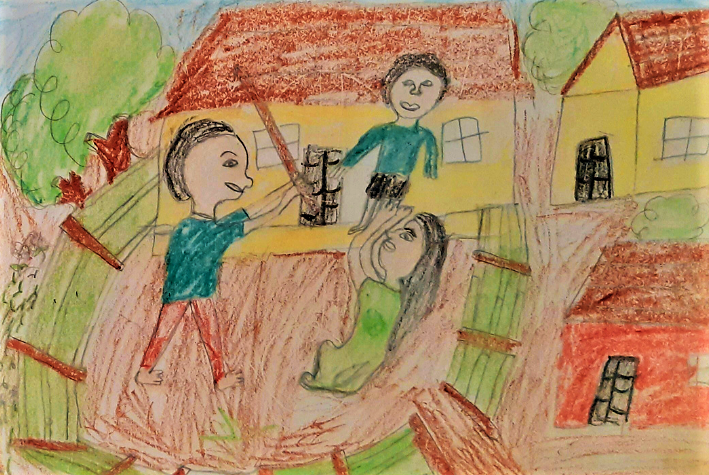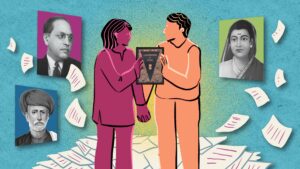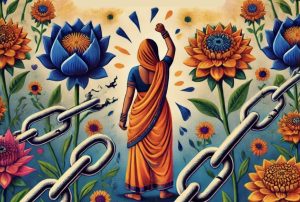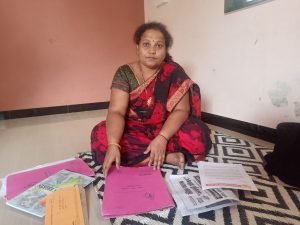Gender Based Violence Among Adivasis Comes From Long Years Of Paternalist, Upper Caste Administration
‘Modern’ institutions like schools, colleges, hospitals, media and the district and state administrations have played a big role in shaping the gender dynamics among Adivasis

Trigger Warning: Mentions of violence.
In the last week of July, a video from a high school hostel in the Bijapur district of Bastar province went locally viral. A number of Adivasi youths circulated it over WhatsApp before it reached me through a friend. In the video, a young man and a young woman are seen in a hostel room. One can also hear the voice of a third person, the one making the video. The girl can be heard asking for her mark sheet (school scorecard), to which the young man first responds verbally in anger and then kicks her in the belly. The girl collapses in pain on the floor, and the video maker says: “Why are you beating her?”
A Class 12 student, Vetti Mahesh*, who shared the video with us, wondered how the offender should be punished. This question set us off on a conversation on several related issues: What is the punishment for such an act under the Indian legal system? What would have been the customary ways of dealing with violence in the Koya Adivasi community to which the young people belong? Was there violence against women in Adivasi societies in the old days? What did that look like? Who perpetuates the violence today, and how?
In this essay we delve into these questions, even as we examine the status of women in Adivasi societies. Few scholar activists and poets from within the communities have questioned the informal and ubiquitous presence of patriarchy even among the ‘partially matriarchal’ Adivasi communities of Chhattisgarh and Jharkhand.
My young friend Mahesh who has witnessed his father beat his mother for many years, says, “It has become a parampara, a tradition. It is too common for men to get angry with women, scold women without any fault of theirs, and beat them after drinking. “My father beats my mother only when drunk, and he has been doing this for many years. Unlike non-Adivasi families, the husband’s family members do not show violence or beat women. Most often, it is the husbands who beat their wives. My father did not beat us children. It was only my mother he would go after.”
Gendered Division Of Labour And Traditional Societies
On the question of how this would be dealt with customarily, Mahesh says: “Looking at the video, I feel so angry that I want to punish the boy. However, traditionally, if the girl’s family gets to know about this incident, they would take action against him. In a quarrel between a married couple, if the family gets involved and this results in the woman returning to her natal family, it becomes a big issue. Then the women’s family can call a panch (the council of village elders) who ‘fine’ the husband’s family in the form of money, pigs, or goats, whatever the elders decide. After receiving the penalty, the elders will give a feast using the fine money and animals for the people of the two villages. Their intervention will be towards getting the families to reconcile.”
Most traditional societies, whether patrilineal/patrilocal or matrilineal/matrilocal, are segregated on the basis of sex. In practice, most societies draw heavily from some (and different) forms of paternalism and patriarchy where men are more equal than women. However, in these societies the presence of gender-based violence is another matter.
Among the Adivasi community of Bastar too, there are customary laws that divide rituals and chores strictly along the sex/gender binary, and there is no recognition yet of the queer/trans people. Further, with a few exceptions, there is a strictly gendered division of labour. In almost all households, women and young girls do more chores than boys and men. Among the domestic chores, young girls start with cleaning and sweeping the house from the age of seven or eight years. By the time they are teenagers, they are equipped and expected to perform most domestic chores of cooking, cleaning, laundry, cutting and bringing firewood from the forest,
and fetching water from the public hand pump. They also contribute to the household economy by working in their fields, doing agricultural labour for others, gathering forest produce like mahua flowers and seeds, mangoes, tamarind, plucking tendu leaves, and making mahua liquors. On the other hand, boys engage in farm work, cattle herding and grazing, tapping trees for local liquor, and gathering forest produce.
Mahesh says that his two younger sisters had to drop out of school after completing Classes 5 and 8, respectively because their father said the girls would be home and doing household chores. Mahesh says: “I was too young to fight for my sisters, and after leaving school for a few months or a year, even they lost interest in studying. Now if someone asks them to go back to school, they will not be able to do so.” He perceives this as a form of violence against women, as are the customary restrictions during women’s menstrual period.
Mahesh explains that the problem is not that there are menstrual rituals around what women cannot do in her periods – touch certain things, fetch water, or cook. The issue is why can a man not do these chores on days when women menstruate. Why does a man have to get angry if the woman takes a break from work during her menstruation, he asks.
While girls from the Durwa community are not allowed to plough or enter the kitchen during their periods, girls of the Koya community do not go on ritual hunts. Boys rarely participate in domestic chores like cooking and laundry. Older women and men both participate in the trades of forest produce. Whether the gendered division of labour, and unequal status of women among these communities amount to gender-based violence or not is a discussion for another day.
Here, let us make a distinction between traditional gendered division of labour and modern forms of restrictions on women’s movement and freedom. It is the latter constraints, or the micro aggressions, that I will be focusing on in this essay.
Documenting Violence At Multiple Levels
For many young people in Bastar, violence against women manifests at different levels. One, there is the obvious and very well-documented State violence against women. This has been recorded in the cases of many women who have been raped and assaulted by military forces. However, what remains underexplored is domestic violence and how it gets entangled with the Hindu patriarchy that has been making inroads into the Adivasi familial spaces for decades now. Patriarchy and gender-based violence among Adivasi societies is a complex practice mediated by the prolonged presence of paternalist state administration dominated by non-Adivasi and often men from the Savarna castes.
In order to understand the violence against women in Adivasi societies of south Bastar, one will have to account for the presence of Hindu rulers in the area for over six centuries and a predominantly Hindu administration post-Independence. Since Adivasi communities are not isolated from the caste-Hindu societies, one cannot factor out the influence of gendered practices among Hindus on Adivasi societies. Further, hegemonic ‘modern’ institutions like schools, colleges, district and state administrations, hospitals, and media have played a greater role in shaping and or influencing gender dynamics in Adivasi customary systems.
Although there is limited scholarship on detailed gender dynamics and patriarchy among Adivasi societies, a few scholars have written about the relative freedom and sexual liberties that women and men enjoyed in Bastar in the past. Verrier Elwin’s (1943) extensive work on Gotuls (youth dormitories) among the Muria community of north Bastar is a treatise on the progressive practice of socialisation, co-education, cohabitation and the freedom young people have been given. For Elwin, this was one of the ways society practised gender equality and ensured lower rates of violence against women. Gotuls were banned post-Independence. One wonders, when there was no restriction on cohabitation of girls and boys in the traditional educational space of the Gotuls, how and when did the Adivasi societies go against girls’ education?
In his immersive work with the Durwa community for over 30 years, Madhu Ramnath (2013) writes that women felt free to voice their opinions, and participate in every social activity in their hamlets. There was no practice of covering their upper bodies and no restriction on their movements. Women’s mobility was never constrained except in menstrual rituals around farming and festivals [when women were kept from playing musical instruments]. The women danced the whole night to the tunes of flutes and drums.
However, the arrival of non-Adivasi traders and settlers in the post-1980s constrained women’s lives as they started wearing blouses to the local market, and even in their own spaces, they started fearing the gaze of the outsiders, and the exoticisation and the violence this brought. This was reinforced by the gendered teaching in residential education institutions like the Vanvasi Kalyan Ashram run by Hindu right-wing organisation, the Rastriya Swayamsewak Sangh. Since the early 2000s, as the conflict between the State and the Naxals increased, leading to the heavy militarisation of the area, the violence against women and the control of their freedom has changed forms.
In recent years, there has been much news of military drone cameras being sent to Adivasi hamlets and forested areas, which the community uses for defecation and bathing. With cameras intruding upon their privacy, the Adivasi young women I spoke to feel particularly violated and they are even afraid to walk alone in these areas. On the one hand, women have been spatially constrained to remain in domestic space and on the other, men receive the message about the normalisation of violence.
In his high school hostel, Mahesh was under huge peer pressure to rag junior students. A senior student who did not participate in the ragging would himself face violence. Although administrative action is taken against incidents of ragging and violence, students seldom make any formal complaints. Instead, they accept it as “tradition and carry it forward generationally”, says Mahesh. Despite the ban on corporal punishment in schools and ragging in hostels, both practices are rampant across Bastar.
During the fieldwork for my doctoral research, several girl students from government middle and high schools spoke of their fear of male school teachers, older brothers, fathers, and sometimes, even uncles. In one of the middle schools, I learned that the principal had been suspended for practising corporal punishment against students. However, the villagers (predominantly men from the village council) called him back to teach, believing him to be instrumental in keeping the schools’ teenage boys and girls from falling in love. This hyperlocal and patriarchal control over young people’s and especially girls’ sexuality is a recent but rigid phenomenon.
Understanding Gender Based Violence From An Indigenous Feminist Perspective
Here, it is also essential to understand violence from indigenous perspectives. Writing about the increasing domestic violence against women, indigenous scholars like Rita Laruto Segato (2016) connect violence with colonialism. According to her, the violence against women in contemporary Latin America is the result of the binary structure of settler modernity imposed upon the indigenous world. Violence towards the indigenous people, and especially towards feminine bodies, provides the logic for accumulation, exploitation, and financialization, which result in what Segato calls a “minoritizing scheme” of women’s issues. (Accumulation, exploitation, and financialisation are processes through which capital has been accumulated historically by exploiting natural resources. With the colonial expansion of territories, land and other forms of resources such as finances are concentrated in a few hands.)
Segato’s choice of the word ‘minority’ for describing women is interesting for me – it can include, in its meanings, not just treating women’s issues as minor but also discounting women themselves as minors (like children under a certain age) and a group of people lesser in number than the whole society as compared to the ‘normative’ male populations. There are many colonial anthropological, and later official documents, where Adivasi people have been described as “docile”, ‘’innocent”, and “childlike”.
I extend Segato’s argument of ‘minoritization’ of women’s issues to understand the increasing violence against young indigenous girls in central India. This is an emerging form of violence resulting from the convergence of the “apocalyptic phase of racial capitalism” (Segato, 2016), financialisation, and heteropatriarchy. I locate this violence not only in Latin America but also in Chhattisgarh as the order of violence follows a similar process of othering.
These processes happen at multiple levels in Bastar, and I contend that women are the worst-affected. On the one hand, the entire administration system is predominantly Hindu in its representation, and on the other, Adivasis are constantly made to feel inferior despite the constitutional protections against caste-based discrimination. When they are travelling in private buses they are either given seats at the back or made to stand to give priority to non-Adivasi travellers. When a Savarna collector refuses to meet or listen to the grievances of Adivasi representatives. When in hospitals, Adivasi patients are treated without any dignity, and indigenous healers are insulted for their knowledge systems.
While Adivasi adults face this kind of discrimination in public spaces, children in schools are taught about the normalisation of violence. This normalisation of violence in the micro spaces of schools, hostels, and other public places results in the minoritisation of women and girls. Girls I met during my fieldwork spoke of the immense pressure they feel from their brothers and every man in their household to conduct themselves “appropriately”. Many women, they told me, participated in traditional communal dances at weddings and local festivals with their faces covered so that their brothers would not recognise them. Further, they do not have access to mobile phones as easily as boys and young men do. There is also a form of surveillance of girls’ use of mobile phones, while there was none in the case of young men.
As I have highlighted elsewhere, many of these gendered conducts for young people are taught and inculcated in government schools. Although government schools are constitutionally secular, there is a heavy emphasis on constructing and maintaining Hindu forms of girlhood, which demands a particular form of respectability and servility from young women. The institutions that are set up to ‘empower’ them end-up making them internalise fear and the idea of a male-dominated order.
The videographed violence in the boys’ hostel became a political issue to score points in the upcoming election, and the hostel in-charge was suspended by the administration. But such instances raise the question of important and underexplored issues of microaggression and violence in the domestic and private spheres in Adivasi societies, where women are at the receiving end.
(I thank Neeraj Naidu, a teacher to Adivasi youths and my fellow researcher in Sukma, for always keeping me up-to-date with the happenings in the Bastar area.)
(*Names of the youths changed to protect their privacy.)
We believe everyone deserves equal access to accurate news. Support from our readers enables us to keep our journalism open and free for everyone, all over the world.




